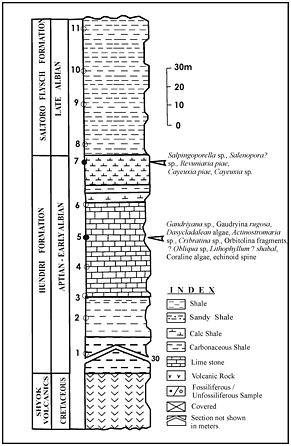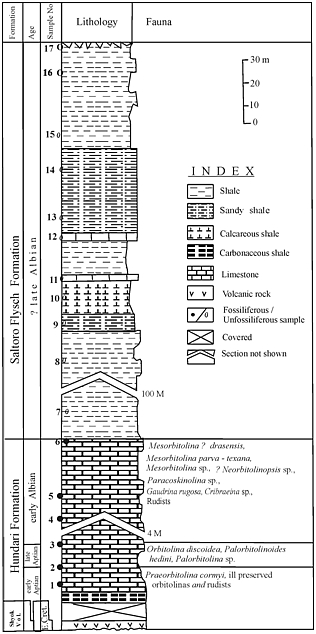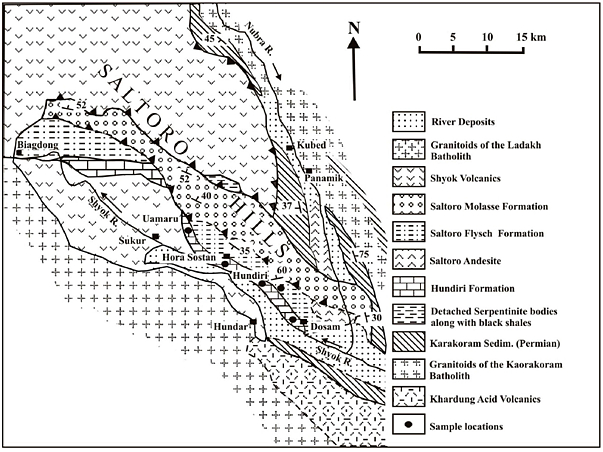Hundiri Fm
Type Locality and Naming
Lower Shyok Valley: Type section is in Sukur Nala section in Lower Shoyk Valley, eastern Karakoram, India. [Original Publication: Gergan, J. T. & Pant, P. C., 1983. Geology and stratigraphy of eastern Karakoram, Ladakh. In: Thakur, V. C. and Sharma, K. K., (eds), Geology of Indus Suture Zone of Ladakh, Wadia Institute of Himalaya Geology, Dehra Dun, India, 99-106; Juyal, K.P. 2018. Lithostratigraphy, biostratigraphy and palaeogeography of the Eastern Karakoram, India. WIHG Monograph series, No. 3. 1-126.]
Lithology and Thickness
Limestone. The Hundiri Formation comprises of dark grey limestone crowded with fossils. Lithologically, this unit comprises limestone and minor shale. The basal portion overlying the Shyok Volcanic Fm is 10 m of carbonaceous shale, which is followed upwards by grey massive limestone.
[Figure 1: Biostratigraphic section of the Sukur Nala, Lower Shyok Valley, eastern Karakoram]
[Figure 2: Biostratigraphic section at Hora Sostan section, Lower Shyok area, eastern Karakoram]
[Figure 3: Biostratigraphic section of Hundiri Formation at Dosan setion, Lower Shyok Valley, eastern Karakoram]
[Figure 4: Geological map of the Lower Shyok valley, eastern Karakoram (modified after Rai, 1991)]
Relationships and Distribution
Lower contact
Not defined; but its basal shale is on the Shyok Volcanic Fm
Upper contact
Not defined. Facies transition to Saltoro Flysch Fm.
Regional extent
Lower Shyok Valley: Due to folding and erosion, the Hundiri Fm and Saltoro Flysch Fm are unevenly distributed at various locations.
GeoJSON
Fossils
After Juyal (2018).
Foraminifer: Praeorbitolina cormyi, Palorbitolinoides hedini, Mesorbitolina ?drasensis, M. parva–texana, Orbitolina discoidea, Mesorbitolina sp., Palorbitolina sp., ?Neorbitolinopsis sp., Paracoskinolina sp., Gaudryina sp., Quinqueloculina sp., Lenticulina sp., Andersania sp.,
Algal taxa: Salpingoporella sp., (Dasycladalean algae); Lithophyllum sp., Rivulariacean fragment, echinoid, crustaceans fragment and rudist.
The following assemblage zones (in ascending order) have been recognised in the limestone succession of the Hundiri Formation at Hora Sostan section (Juyal, 2018).
(i) Praeobitolina cormyi- Rudist Assemblage Zone (Zone-I): This assemblage contains ill- preserved orbitolinids and rudist, in addition to P. cormyi an index early Aptian orbitolinid.
(ii) Palorbitolinoides hedini – Orbitolina discoidea Assemblage Zone (Zone-II):
In addition to these age diagnostic orbitolinids, this assemblage contains Palorbitolina sp., ill-preserved corals and algae. This assemblage indicates a late Aptian age.
(iii) Mesorbitolina ?drasensis – M. parva- exana Assemblage Zone (Zone-III): Besides these age diagnostic orbitolinids, Mesorbuitolina sp., Orbitolina sp., ?Neoorbitolinopsis sp., ill-preserved Rudist and algae were encountered in this assemblage. The faunal assemblage indicates an early Albian age.
(b) Sukur Nala Section = Gaudryina rugosa, Salpingoporella sp., Salenopora? sp. Revularia piae, Cayeuxia piae, Cayeuxia sp., Gaudryina sp., (Triassic–Holocene), Dasycladedance algae, Actinostromaria sp., ?Obliqua sp., Orbitolina fragments, and fragments of Stromatoporoid (Actinostromaria sp.), ?Cribratina sp., Lithophyllum ? shabal, echinoid spines.
(C) Dosam Section = In the Dosam section (Fig. 19) the Hundiri Formation has yielded unidentifiable algae and needs a detailed systematic sampling for further analysis.
Age
Depositional setting
The Hundiri Formation deposition took place in the comparatively shallow water as shown by the fossils contents (Juyal, 2018).
Additional Information



